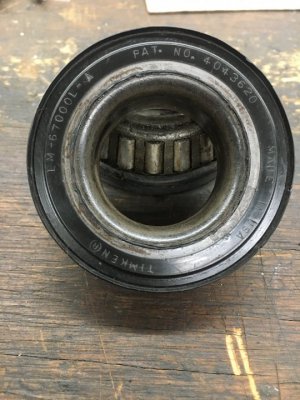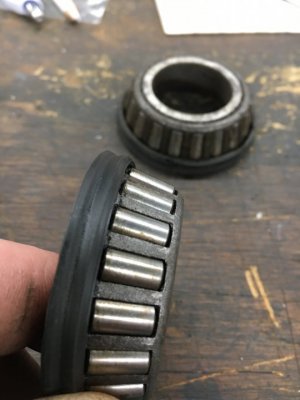Hi Hb.
Thanks for your reply, looking back at what I posted I should have said Wet Dry rather then emery , I will do that use the wet dry. I agree covering the bed of what ever machine you grind on is important to keeping things from going south with grit. I have another larger lathe I can use to make the modified pieces for the 7 x 12. I think I will use the plastic cover as a working model then machine two aluminum plates to replace the plastic.
Its funny you mentioned a two piece cover as I was also thinking along those lines. However I want to explore your idea of creating a well or reservoir for grease. There would be more then enough room to access the back side of the bearing cover behind the mounting plate of the chuck, then its just a matter of smearing grease into the reservoir and putting it back into position. Great Idea !!!
I saw a guy add two threaded holes to the top of the case, one directly over each gear1/4 -3/8th dia. big enough to visually inspect the gears as well as add lube via gravity then made two brass plugs to close them up. Another fellow added a larger plate over the top of the case with a padded surface to lay tooling on. Perhaps a combination of both ideas would allow inspection/lube when needed and a larger surface to lay your chuck wrench or other items as found on larger machines. So many options. LOL.
What mods have you done so far and which ones would you still like to do?
Stan.
As far as mods I've done, in addition to bearings they currently are:
1. A plinth to replace the compound.
2. I added a crank to manuallly drive the lead screw. It is attached to the right end of the lead screw.
3. A DRO for the Z axis. It's mounted behind the bed. I'm currently working on adding one to the cross slide.
4. I replaced the right hand leadscrew bushing block with a version that uses thrust bearings to remove lead screw backlash. I made it with my mill.
5. I replaced the saddle gibs (also called slide plates) with solid gibs that are adjusted using shims rather than the OEM overly-fiddly jack screws.
6. A cover plate for the apron gears. While I had the apron removed, I drilled and tapped some M6 holes for a future DRO mount for the cross slide.
7. I replaced the cross slide nut adjusting arrangement with a double nut design similar to the type seen on anti-backlash nuts for ACME screws. The nuts are solidly bolted to the cross slide, using shims to get them properly aligned to the feed screw. I made the two nuts by cutting an OEM nut in half.
8. I totally worked over the tailstock, which started out life as a POS (unfortunately a common occurrence). That included turning the fixing screw that holds the base to the top around so it can be loosened from the top (making it MUCH easier to adjust the tailstock), and milling the base/top mating surfaces so the top is level and aligned to the bed, both horizontally and vertically. I also replaced the tailstock hold-down nut with one that is tightened using a tommy bar (rather than the more complicated camlock design). It's simple and much easier to use than a wrench.
9. While I had the headstock removed for the bearing replacement job, I also shimmed it so the spindle was better-aligned to the bed. It's a little fiddly because shims rotate the headstock around its rather short width, while you're trying to achieve a small value about twice that far away on the other side. I had to resort to a piece of .0005" shim in the stack to get it right.
The first 4 items were a suite, prompted by a ball-turning tooll I got for the lathe. It's pretty inexpensive but I paid a price for that -- it replaces the compound so it relys on moving the carriage in small controlled steps to turn balls. I did that by adding the handwheel and DRO (there went the "bargain" part of the ball turner

). The carriage is moved by closing the half nuts and turning the crank. And then I realized that the combination was ideal for using a much-more rigid plinth to replace the compound....so I made one. I scraped the plinth and top of the compound so there was plenty of contact for an even more rigid setup. I also scraped the top of the plinth so tool holders also would be well supported. I do still use the compound for some things like cutting threads, turning short tapers and sneaking up on ID's and OD's where I need very precise dimensions.
Item #4 was prompted by my observation that there was a huge amount of backlash when driving the carriage with my hand crank. It was caused by a lot of built-in clearance between the shoulders on the lead screw and the bushing blocks. It wasn't a deal-killer because normal turning operations will take out the backlash, but sometimes it made it difficult to sneak up on a dimension.
I owned and used my lathe for years before doing any of these mods so don't feel like you HAVE to do any of this before you can start making stuff. The mods started to arrive as my confidence in machining grew.
Future mod plans (dreams?) include the cross slide DRO, telescoping lead screw covers and a retractable cover for the lathe bed. The latter is based on a scheme that only an electrical engineer-turned-hobby-machinist could think of....more fun than practical, but that's the nature of the hobby.
I don't turn threads often enough to justify ELS, and so far haven't encountered a problem that would be best solved by doing a CNC mod.




